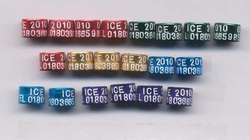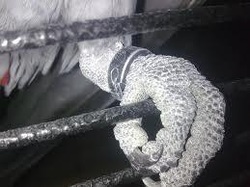IDENTIFICATION GUIDE BY COLOUR

In the UK many parrot breeders ring their birds with colour coded bands. Each year there is a different colour used across the country by different breeders. A good breeder will always use a closed leg ring with no split as these rings can only be placed on the parrots leg at a few weeks old and no later. If your parrot has a split leg ring or no ring at all, it is very possible that your bird was either wild caught ( pre- 1990's in UK ) or reared by the parent birds in an aviary and therefore classed as wild and not used to human contact like hand reared parrots. A closed ring is good proof that the chicks were taken from the parent birds for hand rearing by the breeder and should be tame and used to human contact.
The year indicated by coloured closed rings are as follows :
1990 Light Blue
1991 Green
1992 Pink
1993 Yellow
1994 Red
1995 Dark Blue
1996 Orange / Green
1997 Violet
1998 Green
1999 Light Blue
2000 Yellow
2001 Dark Blue
2002 Red
2003 Violet
2004 Orange
2006 Red
2007 Black
2008 Dark Blue
2009 Violet
2010 Gold
2011 Blue
2012 Red
As you can see many of the colours are rotated, therefore a hatch year cannot be accurate if you are unsure if your bird is young or old, but it is a very good guide!
The year indicated by coloured closed rings are as follows :
1990 Light Blue
1991 Green
1992 Pink
1993 Yellow
1994 Red
1995 Dark Blue
1996 Orange / Green
1997 Violet
1998 Green
1999 Light Blue
2000 Yellow
2001 Dark Blue
2002 Red
2003 Violet
2004 Orange
2006 Red
2007 Black
2008 Dark Blue
2009 Violet
2010 Gold
2011 Blue
2012 Red
As you can see many of the colours are rotated, therefore a hatch year cannot be accurate if you are unsure if your bird is young or old, but it is a very good guide!
IDENTIFICATION OF HAND REARED BIRDS-LEG RINGS

I am often asked how you can tell if a bird is hand reared by humans. A hand reared bird will usually have a closed ring on its leg ( no split in the ring ) These rings can only be put onto the birds leg while the bird is a young chick - around 2-3 weeks old, so it is good evidence that the bird has been handled at a very young age. It is good practice for breeders to do this & most breeders will ring their stock to prove that they have hand reared the bird. Hand reared birds are more expensive so why would they not want to prove that they are tame birds! So it is always essential that you check for a closed leg ring when considering purchasing a hand reared bird. You will notice on the ring that there is various letters & numbers. The letters are usually the breeders identification & the numbers indicate the year the bird hatched, so to find out how old your grey is simply check the year on the leg ring! Split rings are not the same as a closed ring. If your bird has a ring with a split in it this indicates that the ring was put on at a much older age. They usually do not have any lettering on them but sometimes a number. These rings are usually put on wild parent reared birds who have had very little human contact if any or on wild caught imported birds. These quarantine rings on wild caught parrots are applied while the bird is in quarantine waiting to be exported. If there is no ring present it can be assumed that the bird is also a wild caught or parent reared and also wild. Split rings can easily be applied or removed where as the closed rings cannot. Sometimes when purchasing a hand reared bird, a breeder will also give you a hatch certificate, this is great if they do as it will have details on it such as hatch date, breeder identification & sometimes tells you the sex of the bird if the breeder has chosen to have the bird DNA sexed, not all breeders will provide this but its a bonus if they do! Some parrots have both a closed ring and a split ring, these split rings are usually sexing rings to give information about your parrots gender ( see article : Gender leg rings ).
